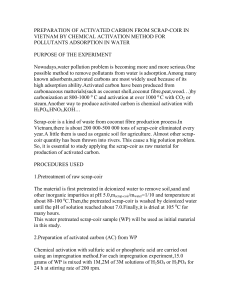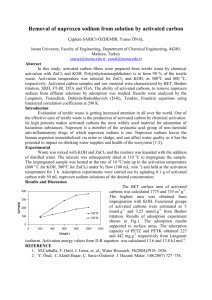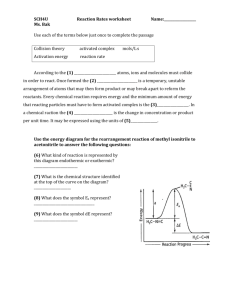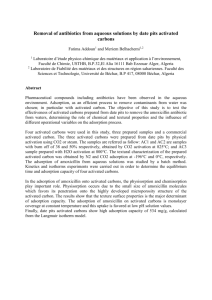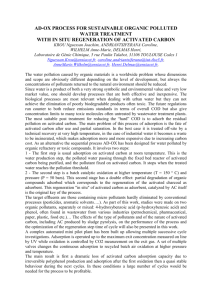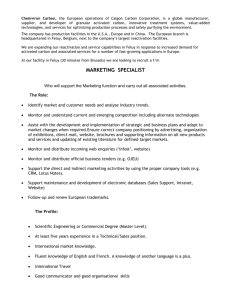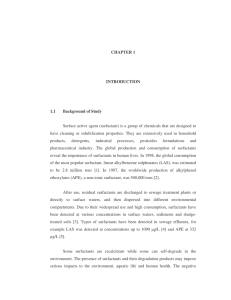1. Verge, C., Monero, A., Bravo, J., and Berna, J.L. Influence... on the bioavailability and toxicity of linear alkylbenzene sulphonates (LAS).
advertisement
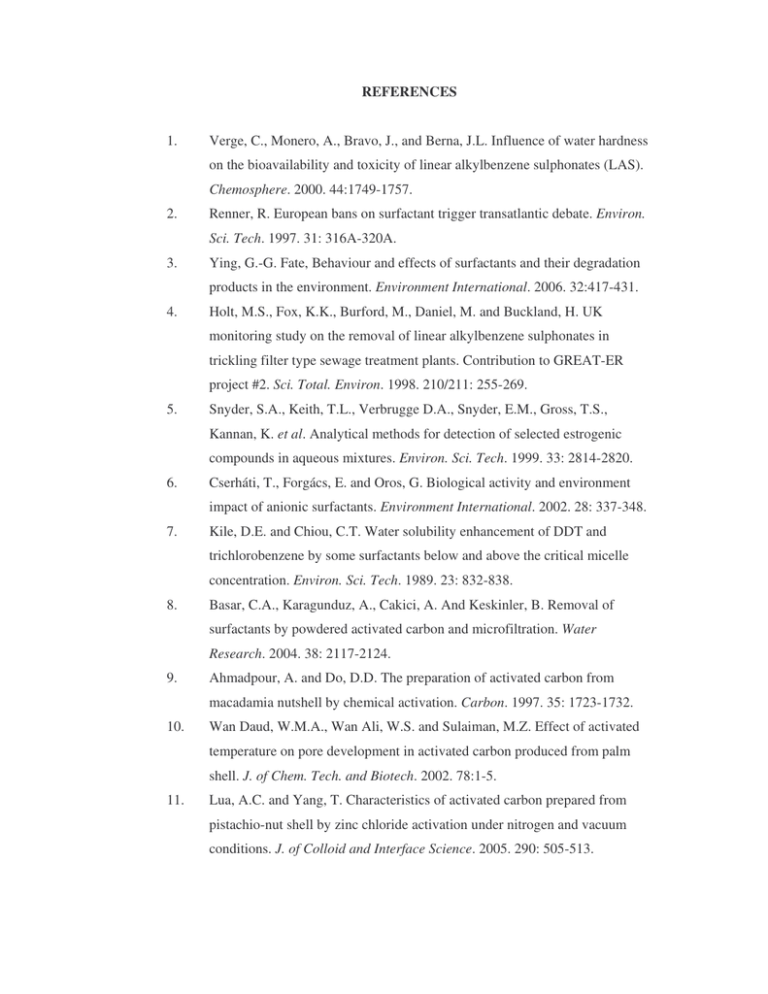
REFERENCES 1. Verge, C., Monero, A., Bravo, J., and Berna, J.L. Influence of water hardness on the bioavailability and toxicity of linear alkylbenzene sulphonates (LAS). Chemosphere. 2000. 44:1749-1757. 2. Renner, R. European bans on surfactant trigger transatlantic debate. Environ. Sci. Tech. 1997. 31: 316A-320A. 3. Ying, G.-G. Fate, Behaviour and effects of surfactants and their degradation products in the environment. Environment International. 2006. 32:417-431. 4. Holt, M.S., Fox, K.K., Burford, M., Daniel, M. and Buckland, H. UK monitoring study on the removal of linear alkylbenzene sulphonates in trickling filter type sewage treatment plants. Contribution to GREAT-ER project #2. Sci. Total. Environ. 1998. 210/211: 255-269. 5. Snyder, S.A., Keith, T.L., Verbrugge D.A., Snyder, E.M., Gross, T.S., Kannan, K. et al. Analytical methods for detection of selected estrogenic compounds in aqueous mixtures. Environ. Sci. Tech. 1999. 33: 2814-2820. 6. Cserháti, T., Forgács, E. and Oros, G. Biological activity and environment impact of anionic surfactants. Environment International. 2002. 28: 337-348. 7. Kile, D.E. and Chiou, C.T. Water solubility enhancement of DDT and trichlorobenzene by some surfactants below and above the critical micelle concentration. Environ. Sci. Tech. 1989. 23: 832-838. 8. Basar, C.A., Karagunduz, A., Cakici, A. And Keskinler, B. Removal of surfactants by powdered activated carbon and microfiltration. Water Research. 2004. 38: 2117-2124. 9. Ahmadpour, A. and Do, D.D. The preparation of activated carbon from macadamia nutshell by chemical activation. Carbon. 1997. 35: 1723-1732. 10. Wan Daud, W.M.A., Wan Ali, W.S. and Sulaiman, M.Z. Effect of activated temperature on pore development in activated carbon produced from palm shell. J. of Chem. Tech. and Biotech. 2002. 78:1-5. 11. Lua, A.C. and Yang, T. Characteristics of activated carbon prepared from pistachio-nut shell by zinc chloride activation under nitrogen and vacuum conditions. J. of Colloid and Interface Science. 2005. 290: 505-513. 74 12. Sudaryanto, Y., Hartono, S.B., Irawaty, W., hindarso, H. and Ismadji. High surface area activated carbon prepared from cassava peel by chemical activation. Bioresource Technology. 2006. 97: 734-739. 13. Vernersson, T., Bonelli, P.R., Cerrella, E.G. and Cukierman A.L. Arundo donax cane as a precursor for activated carbons preparation by phosphoric acid activation. Bioresource Technology. 2002. 83: 95-104. 14. Wan Daud, W.M.A. and Wan Ali, W.S. Comparison on pore development of activated carbon produced from palm shell and coconut shell. Bioresource Technology. 2004. 93: 63-69. 15. Ismadji, S., Sudaryanto, Y., Hartono, S.B., Setiawan, L.E.K. and Ayucitra, A. Activated Carbon from Char Obtained from Vacuum Pyrolysis of Teak Sawdust: Pore Structure Development and Characterization. Bioresource Technology. 2005. 96: 1364-1369. 16. Qiao, W.M., Song, Y., Huda, M., Zhang, X., Yoon, S.-H., Mochida, I., Katou, O., Hayashi, H. and Kawamoto, K. Development of carbon precursor from bamboo tar. Carbon. 2005. 43: 3021-3025. 17. Choy, K.K.H., Barford, J.P. and McKay, G. Production of activated carbon from bamboo scaffolding waste-process design, evaluation and sensitivity analysis. Chemical Engineering Journal. 2005. 109: 147–165. 18. Mizuta, K, Matsumoto, T., Hatate, Y., Nishihara, k. and Nakanishi, T. Removal of nitrate-nitrogen from drinking water using bamboo powder charcoal. Bioresource Technology. 2004. 95: 255-257. 19. Rozad, F., Otero, M. and García, A.I. Activated carbons from sewage and discarded tyres: Production and optimization. J. of Hazardous Materials. 2005. B124: 181-191. 20. Dombrowski, R.J., Hyduke, D.R. and Lastoskie, C.M. Pore size analysis of activated carbons from argon and nitrogen porosimetry using density functional theory. Langmuir. 2000. 16: 5041-5050. 21. Hussain, A. and Mohd Saiyudin, N.K.W. Introduction to Surface and Colloid Chemistry. Monograph 1st ed. Universiti Teknologi Malaysia. 2005. 22. Marsh, H. Adsorption methods to study microporosity in coals and carbons – a critique. Carbon. 1987. 25: 49-58. 75 23. Goh, P.S. Physical characterization of activated carbon prepared from different types of activation method and condition. B. Sc. Thesis. Universiti Teknologi Malaysia; 2005. 24. Ahmadpour, A. and Do, D.D. The preparation pf active carbons from coal by chemical and physical activation. Carbon. 1996. 34: 471-479. 25. Cao, Q., Xie, K.C., Lv, Y.K. and Bao, W.R. Process effects on activated carbon with large specific surface area from corn cob. Bioresource Technology. 2006. 97: 110-115. 26. Önal, Y., Akmil-Ba ar, C., Eren, D., Sarıcı-Özdemir, Ç. and Depci T. Adsorption kinetics of malachite green onto activated carbon prepared from Tunçbilek lignite. J. of Hazardous Materials. 2005. B128: 150-157. 27. Bansode, R.R., Losso, J.N., Marshall, W.E., Rao, R.M. and Portier, R.J. Pecan shell-based granular activated carbon for treatment of chemical oxygen demand (COD) in municipal wastewater. Bioresource Technology. 2004. 94: 129-135. 28. Iwasaki, S., Fukuhara, T. Abe, I., Yahagi, J., Mouri, M., Iwachima, Y., Tabuchi, T. and Shinohara, O. Adsorption of alkylphenols onto microporous carbons prepared from coconut shell. Synthetic Materials. 2001. 125: 207211. 29. Mohd Salih, S. Perbandingan penjerapan paraquat dengan menggunakan karbon teraktif yang diubahsuai dan tanpa ubahsuai dengan surfaktan oktadesiltriklorosilana. B. Sc. Thesis. Universiti Teknologi Malaysia; 2005. 30. Tchobanoglous, G., Burton, F.L. and Stensel, H.D. Wastewater Engineering: Treatment and Reuse. 4th ed. New York: McGraw-Hill. 2004. 31. Abe, I., Fukuhara, T., Maruyama, J., Tatsumoto, H. and Iwasaki, S. Preparation of carbonaceous adsorbents for removal of chloroform from drinking water. Carbon. 2001. 39: 1069-1073. 32. Arslano lu, F.N., Kar, F. and Arslan, N. Adsorption of dark coloured compounds from peach pulp by using powdered-activated carbon. J. of Food Eng. 2005. 71: 156-163. 33. Yehaskel, A. Activated Carbon: Manufacture and Regeneration. New Jersey: Noyes Data Corp. 1978. 34. Dransfield, S. and Widjaja, E.A. Plant Resources of South-East Asia No. 7 Bamboos. Leiden, Netherlands: Bachhuys Publishers. 1995. 76 35. Mohmod, A.L. Guidelines on Blinds and Satay Stick Production. FRIM Technical Information 2. Kuala Lumpur, Malaysia: Forest Research Institute Malaysia.1987. 36. Othman, A.R., Mohmod, A.L., Liese, W. and Haron, N. Planting and Utilization of Bamboo in Peninsular Malaysia. FRIM Research Pamphlet No. 118. Kuala Lumpur, Malaysia: Forest Research Institute Malaysia.1995. 37. Jönsson, B., Lindman, B., Holmberg, k. and Kronberg, B. Surfactants and Polymers in Aqueous Solution. England: John Wiley & Sons. 1998. 38. Porter, M.R. Handbook of Surfactants. 2nd edition. Glasgow, U.K.: Blackie Academic & Professional. 1991. 39. Flick, E.W. Industrial Surfactants. 2nd edition. Park Ridge, New Jersey: Noyes Publications. 1993. 40. Ponec, V., Knor, Z. and erny, S. Adsorption on Solids. London: Butterworth. 1974. 41. Atkins, P. and Paula, J.d. Atkins’ Physical Chemistry. 7th edition. New York: Oxford University Press. 2002. 42. Johari, O. and Samudra, A.V. Scanning Electron Microscopy. In: Kane, P.F. and Larrabee, G.B. Characterization of Solid Surfaces. New York: Plenum Press. 0.7-146; 1974. 43. Bertin, E.P. Principles and Practice of X-Ray Spectroscopic Analysis. New York: Plenum Press. 1975. 44. Gregg, S.J. and Sing K.S.W. Adsorption, Surface Area and Porosity. London: Academic Press. 1982.
